Died Unknown Children Andal | Honors Alvar saint | |
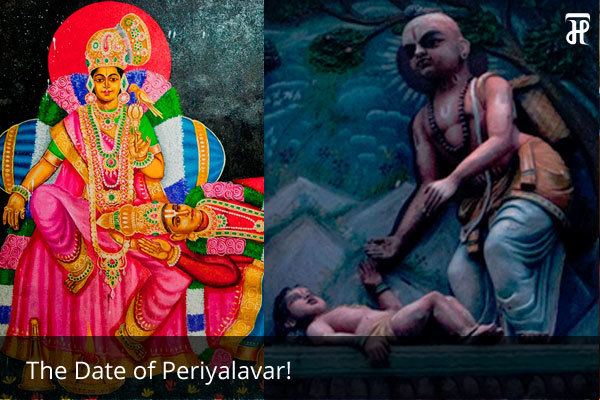 | ||
Literary works Tirupallandu, Periya Azhwar thirumozhi Similar Andal, Nammalvar, Kulashekhara Alwar | ||
Periyalwar or Periazhwar (3055 BC, a mythology estimate) is one of the twelve azhwar saints of South India, who are known for their affiliation to Vaishnava tradition of Hinduism. Vishnucitta or Periyalwar incarnated on this earth in the 47th year after the beginning of the Kali Era (3102 BC). The verses of azhwars are compiled as Nalayira Divya Prabandham and the 108 temples revered are classified as Divya desam. According to some accounts, Periyazhwar is considered the first in the line of the twelve azhwars, while other accounts place him as the eighth. His original name is Vishnuchittar, since he blessed Lord Vishnu assuming he is elder to the Lord, he is called Periazhwar.
Contents
- Azhwars
- Early life
- Andal
- Works
- Culture
- Periyazhvars unconditional love towards Lord sri krishna
- References
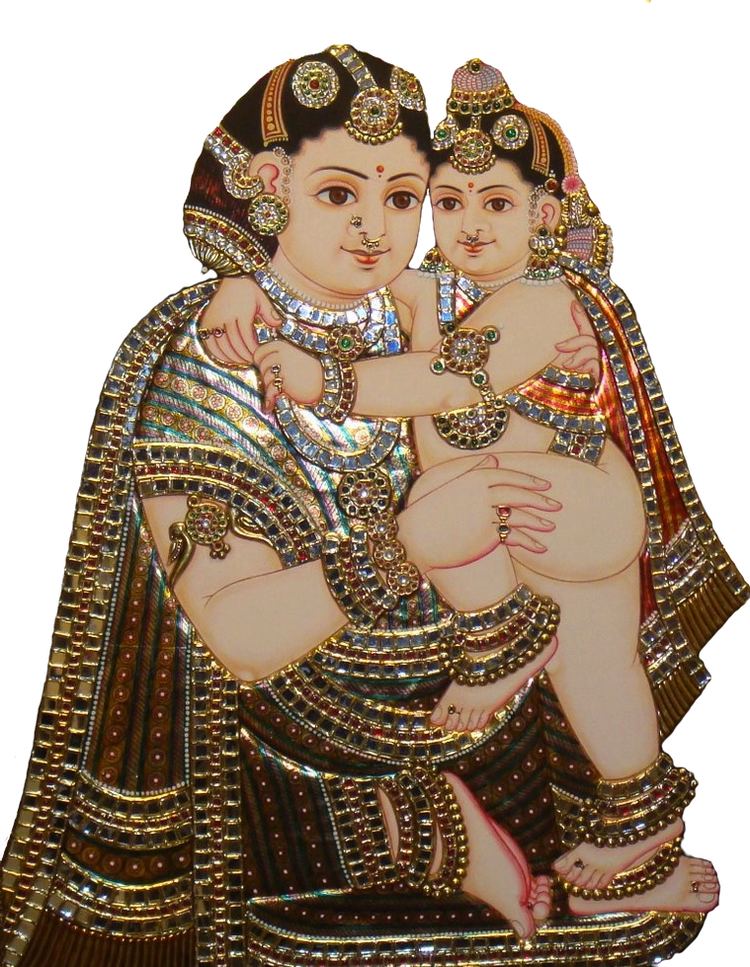
Related to his birth, the traditional scriptures mention that Goda Devi or Andal, the daughter of Vishnuchittar incarnated on this earth in the 98th year after the beginning of the Kali Era (3102 BC). As per Hindu legend, Periyazhwar was the foster father of Andal, the only female azhwars.The works of Periyazhwar contributed to the philosophical and theological ideas of Vaishnavism. His contributions are Thirupallandu and Periya Azhwar thirumozhi among the 4000 stanzas in the Nalayira Divya Prabandam.
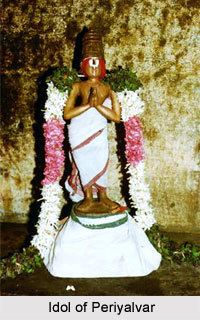
In South-Indian Vishnu temples, Periyazhwar has images and festivals associated with him. The Garudasevai festival in Srivilliputhur temple, where five Vishnu temples in the region participate, is an event dedicated to him. The verses of Periyazhwar and other azhwars are recited as a part of daily prayers and during festive occasions in most Vishnu temples in South India.
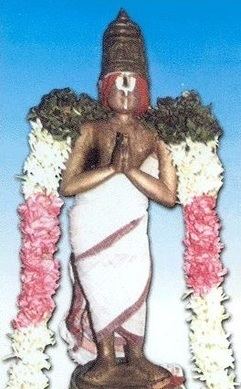
Azhwars

The word azhwar means the one who is immersed/dives deep into the nectar/ocean of the countless attributes of god. Azhwars are considered the twelve supreme devotees of Vishnu, who were instrumental in popularising Vaishnavism. The religious works of these saints in Tamil, songs of love and devotion, are compiled as Nalayira Divya Prabandham containing 4000 verses and the 108 temples revered in their songs are classified as Divya desam. The saints had different origins and belonged to different castes. As per tradition, the first three azhwars, Poigai, Bhutha and Pey were born miraculously. Tirumizhisai was the son of a sage, Thondaradi, Mathurakavi, Peria and Andal were from brahmin community, Kulasekhara from Kshatria community, Namm was from a cultivator family, Tirupana from panar community and Tirumangai from kazhwar community. Divya Suri Saritra by Garuda-Vahana Pandita (11th century AD), Guruparamparaprabavam by Pinbaragiya Perumal Jiyar, Periya tiru mudi adaivu by Anbillai Kandadiappan, Yatindra Pranava Prabavam by Pillai Lokacharya, commentaries on Divya Prabandam, Guru Parampara (lineage of Gurus) texts, temple records and inscriptions give a detailed account of the azhwars and their works. According to these texts, the saints were considered incarnations of some form of Vishnu. Poigai is considered an incarnation of Panchajanya (Krishna's conch), Bhoothath of Kaumodakee (Vishnu's Mace/Club), Pey of Nandaka (Vishnu's sword), Thirumalisai of Sudarshanam (Vishnu's discus), Namm of Vishvaksena (Vishnu's commander), Madhurakavi of Vainatheya (Vishnu's eagle, Garuda), Kulasekhara of Kaustubha (Vishnu's necklace), Periy of Garuda (Vishnu's eagle), Andal of Bhoodevi (Vishnu's wife, Lakshmi, in her form as Bhudevi), Thondaradippodi of Vanamaalai (Vishnu's garland), Thiruppaan of Srivatsa (An auspicious mark on Vishnu's chest) and Thirumangai of Saranga (Rama's bow). The songs of Prabandam are regularly sung in all the Vishnu temples of South India daily and also during festivals.
Early life
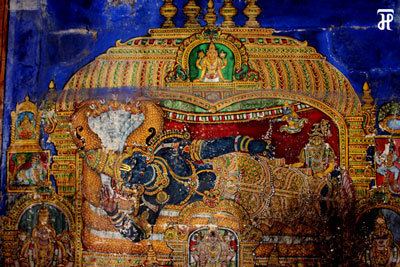
Periyalvar was born into a Brahmin family in Srivilliputhur, near Madurai and was named Vishnuchittar meaning "one who has Vishnu in his mind". Legend says he rejected the vedic philosophical debates of his upbringing to focus on Bhakti (devotion), especially on doing simple tasks for god. He would make garlands of flowers for the deity of the temple. Once the Pandyan king Vallabhadevan had a competition between scholars to find out the path to paramapada. Vishnuchittar won the competition by explaining that the path to moksha is by service to Vishnu. He quoted various historic and Vedic reference to prove his point. The king was satisfied and he honored Vishnuchittar by taking him around the streets of Madurai. It is believed that Koodal Azhagar, the presiding deity in the Koodal Azhagar Temple near Madurai witnessed the event with his consort. Periyalvar was surprised and he immediately composed Thirupallandu, the first twelve verses of Naliyara Divya Prabandam.
Andal
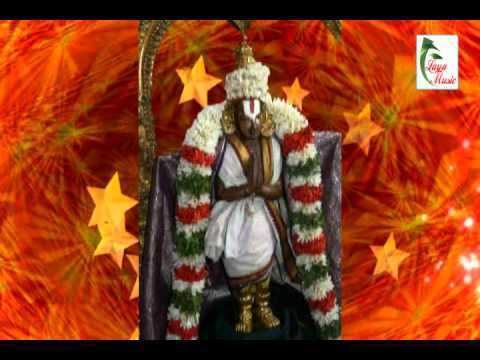
As per Hindu legend, Andal is believed to have been discovered under a Tulsi(Basil) plant in the temple garden of Srivilliputtur, by Vishnuchittar. The childless Vishnuchittar was happy about the child and named her Kodhai. The child was brought up by Vishnuchittar in an atmosphere of love and devotion. Vishnuchittar doted on her in every respect, singing songs to her about Vishnu, teaching her all the stories and philosophy he knew and sharing with her his love for Tamil poetry. As Kodhai grew into a maiden, her love and devotion for Ranganatha (the reclining form of Vishnu) grew to the extent that she decided to marry none but the Ranganatha himself. As days progressed, her resolve strengthened and she started to live in a dream world with her beloved and was constantly fantasizing about marrying him. Vishnuchittar had the responsibility of delivering flower garlands to the Ranganathar temple everyday. Kodhai made these garlands and eventually started wearing the flower garland which was meant to be offered to the deity. However, Kodhai felt she should test to see how the garland suited her and only if it did, she should offer it to the deity. One day, she was caught red-handed by her father in this strange act, and being an orthodox devotee, he was extremely upset. He rebuked her and told her not to repeat the sacrilegious act in the future. Frightened and apologetic, Kodhai made a new garland for the offering that day. Legend says that that very night Vishnu appeared to Vishnuchittar in his dream and asked him why he had discarded Kodhai's garland instead of offering it to him. Vishnuchittar was moved and understood the divine love of his daughter. From that day on, Kodhai is believed to obtained the name "Andal", the girl who "ruled" over the Lord. She is also known by a phrase Soodi kodutha Sudarkodi which means "The bright creeper-like woman who gave her garlands after wearing them". As Andal grew to a marriageable age, Vishnuchittar prepared to get her married to a suitable groom. Andal, however, was stubborn and insisted that she would marry only the god Ranganathar. The father was worried, but Lord appeared in Vishnuchittar's dream and informed him that he would marry Andal at Srirangam. He commanded the priests at Srirangam, in their dreams, to prepare for the wedding. Andal who was anxious to reach Srirangam was unable to control herself in her urgency to meet her beloved. She ran into the sanctum sanctorum of Ranganatha and is believed to have merged with him.
Works
The tower of Andal Temple, is originally believed to have been built by Periazhwar with the prize money he obtained from religious debates in the court of Vallaba Pandya in Madurai.
Vishnuchittar composed a couplet called "pallandu"(பல்லாண்டு) (also called Thirup-Palandu(திருப்பல்லாண்டு) out of respect) translating to "Long live for many years, Long live for many years for Hundreds of thousands of years!" to God. This is a very important prayer in Srivaishnava liturgy today. Vishnuchittar composed some pasurams in the 4000 Divya Prabhandham called Perialvar Tirumozhi where he explores a devotee's love for God through the metaphor of Yashoda's motherly love for Krishna. He was the adopted father of Kodhai or Andal, the only woman alvar.
Periyalwar was fascinated by the childhood exploits of Lord Krishna and developed devotion and love for God, incarnated as Krishna. And he sang of Krishna, the Child Deity, with maternal love. He was more concerned about the welfare of child Krishna than his own. Because of his love and devotion, he was named Perialwar or great azhwar. Apart from his native Srivilliputhur, he visited Thirukoshtiyur, Sri Ranganathaswamy Temple, Srirangam, Tiruvellarai and Azhagar Kovil.
Culture
The devotees of Srivaishnva sect of Hinduism pay respect to the azhwars in a similar vein to their worship of Vishnu. The verses of azhwars are recited as a part of daily prayers and during festive occasions in most Vishnu temples in South India. There are shrines dedicated to the azhwars in most of the Vishnu temples in South India. The Periyazhwar Mangalasasanam festival (also called Aani Utsavam) is celebrated every year during the Tamil month of Aadi (July - August) in the Vadapadrasayi temple in Srivilliputhur. The image of Periyazhwar receives each of the five Vishnu images for Mangalasasanam. Vadapatrasayee Periya Perumal, festival image of Srivilliputhur Divyadesam, Sundararaja Perumal of Kaatazhagar Temple, Srinivasa Perumal of Tiruvannamalai and Thiru Thangal Appan are received by Periyazhwar with different verses from Nalayira Divya Prabandam. In the evening, Garuda Sevai festival is celebrated where all of the festival deities are carried around the streets of Srivilliputhur.
Thousands of people from the state participate in the "Aadi Pooram" festival celebrated in the Andal Temple. After early morning special pujas, the presiding deities, Sri Rengamannar and Goddess Andal are taken in decorated palanquins to the car. The festival marks the adoption of presiding deity, Andal, by Periyazhwar after he found her near a Tulsi plant in the garden of Vadabadrasai Temple at Srivilliputhur on the eighth day of the Tamil month of Adi.
Periyazhvar's unconditional love towards Lord sri krishna
Periyazhvar imagined the temple town of Tirukkoshtiyur in Tamil Nadu to be Gokul, the place where Lord Krishna grew up. The infant Krishna is brought to Gokul and left beside Yasoda. Yasoda wakes up and thinks the child is hers. The news of the baby’s birth brings the Gopas and Gopikas to Yasoda’s house, to have a look at the baby. Those who see Him once are not satisfied with just one visit, and they dance with joy. Periyazhvar gave all these descriptions in his Tirukkoshtiyur verses. Periyazhvar celebrated almost every stage of Lord Krishna’s childhood through verses, imagining himself to be Yasoda, coaxing Krishna to eat, to bathe etc. Periyazhvar admires infant Krishna sticking his big toe in his mouth.
